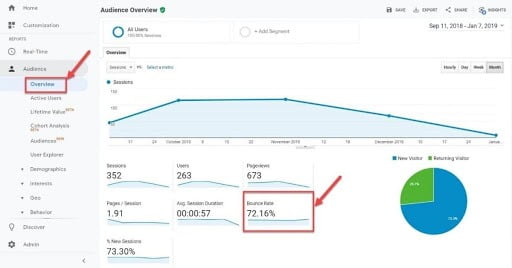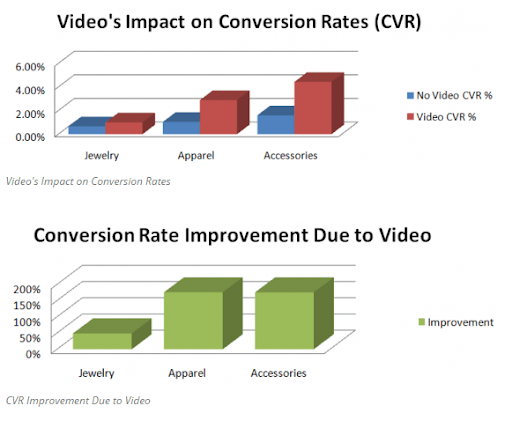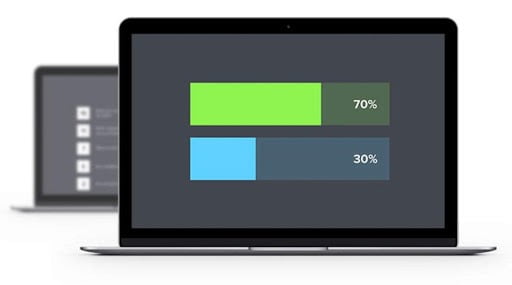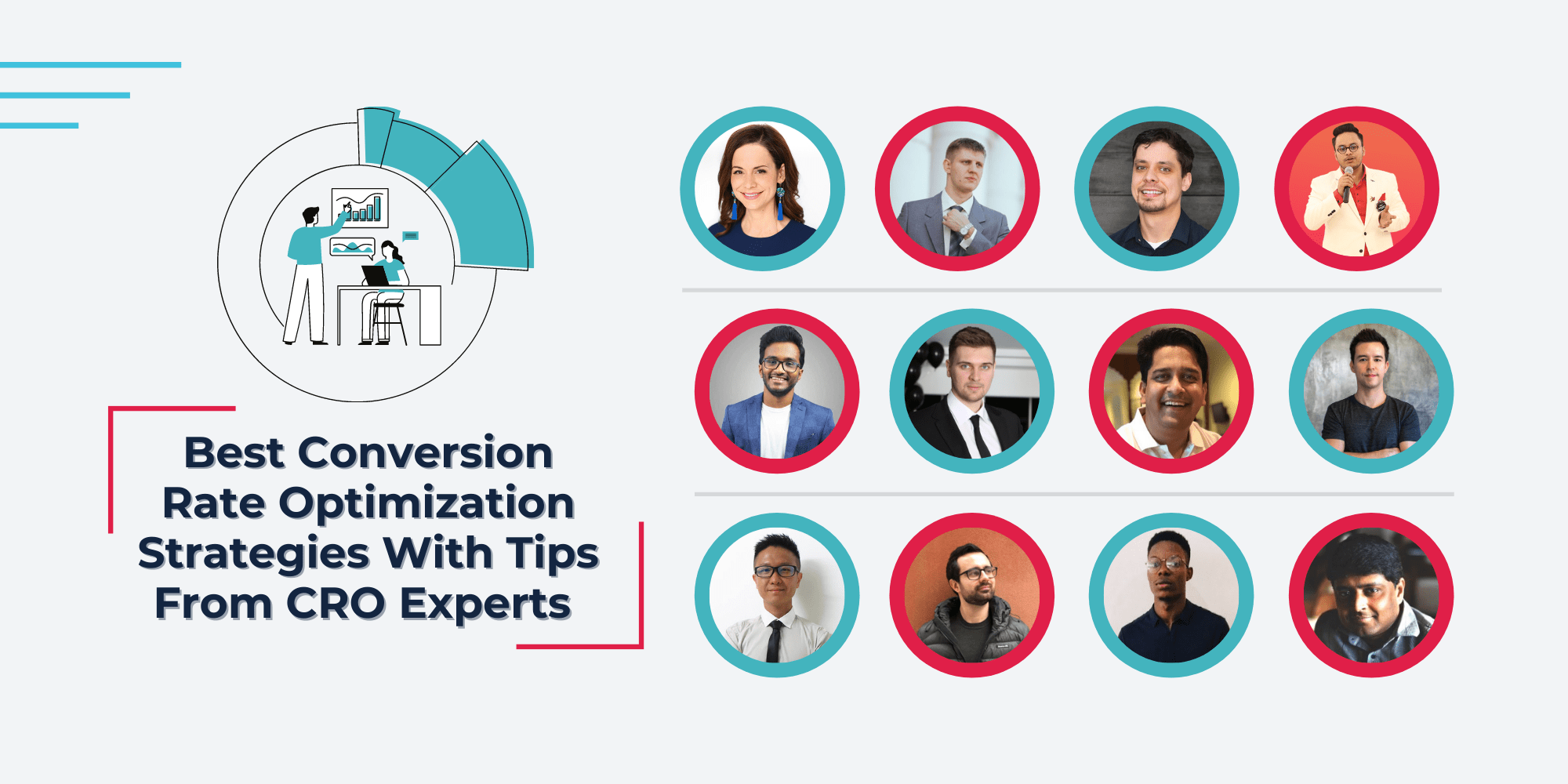Popular Tools by VOCSO
If you wish to improve your conversion rates to bring on more customers to your brand, there are a few methods that can be deployed. Converting leads often involves enticing those prospective customers with something incentivizing which reveals the benefit for them too.
Using data analytics and testing, you can customize your ads to appeal to audiences. With this, sustainable growth can then be achieved. So why not improve your performance to maximize the ROI and drive efficiency like never before? This is one of the quickest and most effective ways to convert your traffic into revenue streams to channelize monetization. If you’re looking to increase your website’s conversion rate, this checklist is for you. Whether you’re a seasoned pro or just getting started, following these best practices will help boost your results. Before exploring more about this conversion rate optimization checklist let’s take a look at some important aspects of conversion optimization.
Table of Contents
What is conversion rate optimisation (CRO)?
Put simply, this is where you boost the proportion of visitors who convert to your site. To exemplify this, a 10% conversion rate essentially means that 10 out of every 100 who visit your site end up being converted (into customers). Akin to a physical store, there may be many prospective customers who merely browse and don’t purchase anything. Conversion optimization ensures that your funnels are seamlessly integrated and enriches your offer value. This is based on user activity and subsequently, you can improve your landing page. This is what makes all the difference and we’ll explore conversion rate optimization strategies in further detail here in this article.
What is conversion rate and how is it calculated?
This is a ratio that expresses the percentage of your site visitors that actually convert.
The formula is straightforward:
Total transactions / Total site visits X 100 = (conversion rate)
For instance, let’s presume that 100 people visited your site in the previous month, and out of those visitors, 3 ended up purchasing a product or service (as the case may be).
Hence the conversion rate would be 3% (3 / 100 X 100), as both hundreds effectively cancel out each other, so you’re just left with 3. In case 10 people converted, the rate would rise, more than trebling to 10 percent.
According to the nature of your business, you’d focus on one of the following executions as your main aim:
- To purchase something
- Request for a demo
- Opt for a trial or complimentary account/enrolment or email subscription
- Completing a lead form
- Clicking on an ad
These are also known as macro conversions, as they’re the overall objective of your site. You may have micro conversions as well which are the smaller stages involved leading up to bigger conversion goals. Examples include social media distribution, particular page views, adding products to a shopping cart, downloading and viewing media (to name but a few). Always concentrate on the macro conversion of your site when referring to the entire conversion rate.
Interpreting conversion optimisation aspects
Conversion rate optimization is multifaceted, so here’s an explanation of these factors:
- Call to action (CTA): Instruct visitors on their next course of action
- Conversion funnel: ordered stages required to fulfill the main objective of your site
- A/B testing: This is a popular way to gauge conversion progress by comparing the effect of at least two independent versions of your site on visitor conversion. The rates are then analyzed accordingly
- Multivariate testing (MVT): Similar to A/B testing however with the addition of multiple variables being deployed simultaneously
- Usability: Guidelines to improve your site’s ergonomics by reducing funnel friction for a smoother experience. This boosts conversions
- Customer development: Solutions to understand your customers more, as this helps to create sites which convert better
- User recordings: This feature records the user journey/activity on your site. Such monitoring analyses bottlenecks to reveal their intended path. Now you can improve by fixing accordingly!
- Google Analytics: This counts visitors and users with the view to increase conversion with optimized native and integrated data with event measurement for CTR intent. Improves ergonomics to attract more visitors by monitoring activity and its impact.
- Google Search Console: Improve visibility and indexing status for better conversions
- Google Optimise: Improves the user interface design by scrutinizing various combinations to drive conversions
- Heatmaps: These reports highlight the popular clicked areas to master and target
Advise your customers on how to proceed with a robust and appealing CTA.
The main components of CRO:
This is a multi-factored and detailed process involving various steps. A good campaign deploys data-based analytical results, is vigorously tested, adjusts content to increase relevance, and summarises appropriately. Marketers will find the following aspects (Conversion Rate Optimisation Strategies in 2023) which may need optimization:
Landing Page Design
This determines the ergonomics and your site’s progress, as the visual appeal will attract greater audiences, ready to convert. Exemplifying visitor intent to buy is important, as many eCommerce sites will create all of their product pages to highlight subtle details as well. Customers can for example add products to carts with a dedicated CTA button which will typically be labeled in an alluring colour plus accessible too
Website Copy
Traffic is also dependent on and affected by pertinent and evocative written content. This can convince the visitor to remain on your site and take an action (rather than just abandoning it altogether). This can minimize bounce rates and promote better retention too. We can categorize this into two subcategories:
1. Headline
This is the initial entity that visitors are greeted with on your landing page and offers a welcome notion. This is your make or break, so concentrate on these:
Formatting – this should be ergonomic in terms of font style, size, and colour theme to engage them and be perusable.
2. Writing Style – be mindful of
Pose a thought-provoking (albeit rhetorical) question, such as ‘Have you ever wondered how you can improve your enterprise revenue?’ This evokes interest. Divide your material into two sections i.e. ‘Online sales: what to do next?’
Try to address or salute in a straightforward manner – e.g. ‘Is SEO really worth it?’
Become quantitative – e.g. a dozen methods to boost conversion rates!
Either way (in any case) keep your headline concise and relevant to what you’re promoting.
3. Body Content
This is essential and should be well structured to convey the direct benefit for the customer. It should also be coherent and represent your brand well, upholding its image.
Try doing this:
A. Formatting
Segregate material into digestible chunks with paragraphs and subheadings
Use bullet points or enumerate lists (if required)
Font style, size, and colour theme should correspond with and complement the brand’s design or framework
B. Writing style
Appropriate tone, according to the intended audience, such as entertaining, professional or educational, and so on.
Stylistic elements including analogies, adjectives, etc to focus on specific topics.
Engage end-users and their purpose, addressing their queries.
Implement key phrases to enhance ergonomics and main points overall landing pages accompanied by other related content that fortifies the main features helps to promote your brand even further. Sharp headlines with consolidated material to address all queries, both enriches and satisfies the expected criteria (which is to invite customers by luring them aboard).
Call-To-Action
A call-to-action (CTA) advises a customer to take action. Ranging from subscribing or enroling, purchasing a service, etc. A versatile and snappy CTA will generate more leads.
Psychologically, the shorter the phrase, the better. So instead of naming your button ‘Sign up for free’, simply put ‘Free registration’.
Navigation and Site Structure
This journey should be accessible for all by linking every page and section seamlessly with the other. The ascending model is used as default to begin from the homepage then search through sections to refine your endpoint result. It needs to be seamless and logical to ensure compliance and no abandonment. Being able to navigate between these areas quickly and with minimal clicks is the ideal and ultimate objective here. By doing so, you can boost conversions plus your brand value.
Forms
These are essential for many brands, as they often formulate the sales funnel. Optimizing such significant customer contact points can drive conversion rates. Various volumes of information work optimally, hence strike a balance between quality and quantity to achieve the best ROI results.
Reduce redundant questions (unless you need detailed geolocation demographic information or lead based details).
Aesthetically pleasing forms correspond with better outcomes via great user experiences. Refrain from special effects, maintain neat and standard styling plus tooltips as well as validation where needed. Arrange fields in order of descending significance to award attention appropriately.
Try progressive forms to improve conversion rates but not sacrificing on detail.
Make the password creation a convenient process to complete the form smoothly. According to internal VWO data, this is the most time-consuming aspect. Hence suggesting users how to easily create a strong yet memorable password is a synergistically positive outcome for all.
One-click form submits via Facebook or Google SSO also boosts the conversion process. Don’t forget that many users are already signed into such sites which promotes conversion easily. This also avoids the hassle of needing to create and recall multiple passwords.
Nevertheless, this may not function everywhere (particularly in B2B settings) where professional work email addresses are used instead.
Page Speed
Load time and latency are imperative, playing a major role in user experience, conversion rate, and search engine ranking as well. Even a difference of milliseconds matters now! Unnecessary delays can prove to be costly and shaving off your time can spearhead your site to the forefront. Don’t risk losing traffic via abandonment or repulsion!
Advantages of Conversion Rate Optimization: its significance
1. Enhancing Marketing ROI
Greater conversion rates suggests an abundant supply of required resources. By analysing how to maximise your acquisition efforts, conversions will increase without the need to onboard more customers. Conversion Rate Optimisation tips also include.
2. Know your customers
You know what they say, knowledge is power. So before you can start optimizing your website, you’ll need to have an in-depth understanding of your customers. The aim is to know who they are, how they interact with your store, and where the bottlenecks in the customer journey are that might prevent them from converting. Data based intelligence should guide your Conversion Rate Optimisation tactics, enabling you to design customer segregated and their anticipated actions, lifecycle stage, and purchases.
3. Acquire a larger customer base and reduce associated costs
Conversion rate optimization best practices aim to assist customers in finding what they need quickly and easily. The better you understand your customers, the greater customization can be applied to their journey. Ultimately, this paves the way to buying the intended products or services. Efficiency is also important, as this helps to convert traffic into monetized pathways. As the customer experience improves, your conversion yield will also increase, boosting your marketing and reducing cost per acquisition (CPA). Consider the economies of scale principle which is based on a similar underlying concept.
4. Enrich your SEO efforts
CRO and SEO can be synergistic and as searches become more agile, user trends now contribute to ranking. Hence sites that offer optimal customer experience will have a superior ranking. All efforts input to improve the customer journey will boost conversions as well as search result rankings.
5. Improve your customer lifetime value
Target your loyal customers (acquired earlier) and value them with recognition in the form of welcome popups, customized product/popular suggestions, or reminder emails to restock on their favorites/frequently purchased items. This helps to convert one-time buyers into long-term customers and boosting retention by making them feel important. These advantages focus on understanding customers, converting them, lowering their CPA, supercharging your SEO, and raising the overall value.
Conversion rate optimization checklist to follow
When it comes to conversion rate optimization, there are some best practices that will always hold true. However, as technology and user behavior evolves, there may be new ways to optimize your website for conversions. In this blog post, we’ll take a look at some of the most important CRO best practices for 2023. By keeping these in mind, you can ensure that your website is effective in converting visitors into customers. Let’s see what it takes to do just that:
#1. Find your target audience
Don’t fall for trying to convert every single activity that’s detected but rather digital marketing follows the observation of user trends to tailor your approach accordingly. Any ambiguity will only lead to fruitless results. Customer Experience, content, CTAs, and assets should be aligned with target customer inclination. They can then contribute to the growth of your business. You can easily identify the target audience by reviewing the nature of current traffic reaching your site.
Demographics including local language, geolocation, affluence, age, and so on are all important determinants when performing CRO. You can also observe the social media activity surrounding your domain to understand your audience. Pay close attention to the subject of posts or discussions to know better.
#2. Engage users immediately
First impressions do always count as is the case in the infancy when even browsing an eCommerce site. These initial moments will captivate your audience and engage them to retain them accordingly. Your site needs to achieve this by delivering the right details to retain interest. Enumerate your promotions, best sellers, seasonal sales, and so forth.
#3. Collate and analyse data
This is essential for CRO and Google Analytics is an ideal tool, particularly for novices. Upon gaining more experience, you may opt for others such as Crazy Egg, Hello Bar, HotJar, etc. Any data gathered from these tools will direct you as to the best strategy to succeed, Monitor trends when analyzing data, as this’ll guide you on how to optimize your conversions. For instance, a posted blog that attracts a significant user volume (however fail to convert) is suggestive of and warrants CRO intervention. User engagement via social media channels is also something to keep an eye on. To illustrate, if one channel is outperforming another in terms of sales, it’s time to review your strategy. This data can be used for this very purpose.
#4. Interpreting consumer behavior is imperative
Prior to embarking upon any workflow for your eCommerce business, you need to realize your target audience, interests, demographic data, geographics, continuing consumer trends & online activity. Knowing what your audience wants will drive your ecommerce conversion optimization strategy in the right direction.
Cookies, analytical tools, and social media tracking can help to understand consumer attitudes. Google Analytics does this by furnishing you with data correlation, user actions, demographics, etc.
#5. Good product visibility & store accessibility
Product discovery (or lack thereof) is a major factor in deciding engagement and bounce/abandonment rates for eCommerce stores. It’s pointless if a customer visits your site but ends up leaving as they were unable to find their desired product (despite it being available on your site). You need to increase visibility and accessibility in order to capitalize upon user intent to engage with and explore your site (ultimately purchasing the product). Hence, this process needs to be convenient and pleasant by improving your site navigation and categorization to organize yourself better.
#6. Offer strategic discounts, promotions, vouchers & competitions
These robust techniques can serve both your business and ecommerce platform too. Everyone relishes being rewarded with something and psychologically, it reinforces the urge to buy. In any case, you can deploy seasonal discounts or for special occasions such as birthdays, anniversaries, etc. This entices consumers and increases conversion rates. Interactive quizzes can also work by encouraging people to purchase a requisite volume of products to be eligible for entering a draw to potentially win certain items or points.
#7. Payment security optimisation is essential
Financial safety is the pinnacle issue for consumers since the Internet began. If a product’s credibility or reputation can impact people’s belief or dependence, just consider the level of trust required to part with their valuable credentials on your site? Authenticity is key to entrust people and boost ecommerce conversion rates. Demonstrate information privacy policies, SSL certifications, offer cash on delivery and other comforting reliable payment options (along with antivirus and interception protection). No one should ever feel vulnerable or violated by the fear of an impending cyber attack!
#8. Apply CTA’s strategically
Call to action buttons are required to easily guide users. Embolden and locate these in prominent places on pages.
#9. Invite exclusivity & influencers
Everyone prefers distinct traits and this draws attention. Why not work with major brands to showcase an exclusive product range on your ecommerce site? This will empower your brand’s identity with great publicity cum advertising and the advantages will be symbiotic. Likewise, influencers can focus or direct/route traffic to your site (as their advice will drive trust across new users).
#10. Continuous SEO for your site
It’s futile when despite having a wonderful product and price lineup, users are still unable to locate or even notice your site upon searching? Hence SEO is paramount to optimize your pages and their respective material. Now when people search using pertinent keyword criteria, you’ll flash as the ideal choice on the SERP (Search Engine Results Page). Maximizing this along with backlinks will give you more exposure and attract as much traffic as possible to your site. On page optimisation will improve user retention, engagement and ultimately conversions!
#11. Mobile device optimisation takes precedence
The latest stats estimate that now over half of the global population owns a smartphone device. Out of these, four-fifths have bought something online using their phone within the last half year. Mobile based ecommerce is developing daily and research demonstrates that the likelihood of a visitor converting to a customer plummets by as much as three-fifths following a poor optimization experience. Google continuously updates and potentiates mobile based frameworks, such as introducing their mobile-first approach. Hence by optimizing your eCommerce platform to function synchronously with mobile devices, you’ll be able to outperform your rivals.
Ready to achieve and secure top spot in Google SERPs for your website with VOCSO SEO services? We’re empowering brands with excellent quality. Scan your site with a free website SEO audit for 50+ checks and how to fix suggestions to boost your online presence.
#12. Your material should be both interactive & modest
While displaying pertinent product information is crucial, it’s also worth creating interactive material to add authenticity too (rather than hardcore marketing/selling). Why not throw in some amusement and innovation to engage people: don’t restrict yourself to merely presenting details. Highlight your unique selling points instead, as this’ll help to boost your conversion rate.
#13. A/B (split) testing
This is a versatile method to improve CRO by configuring accordingly to achieve stellar performance. This should be undertaken frequently to keep up with current trends. Whatever you decide should ultimately be based on the data based intelligence reaped by conducting these tests (to compare which fares better against the other). Try implementing different CRO strategies to scrutinize which works best. This could involve variations in material, creation, CTA buttons, or any other suitable aspects which involve SEO.
Primarily, this process helps to identify which combination of factors will produce maximal conversion. This may be offered as an integrated feature within some tools like CrazyEgg. These are beneficial as they automate this data collection and analysis.
#14. Interpret the customer experience
Prior to beginning the CRO process, establish the various stages of the customer journey. A competent marketing funnel will highlight the optimization needs at each step. Using Google Analytics or alternatives can assist in extracting user engagement stats/data. To exemplify, your site may be drawing in much traffic via blogs, and these are coveted as being high up in funnel marketing. In case the conversion rate is nil here (i.e. no subscribers yet), then you really need to improve these.
At the other end of the scale, a PPC landing page may receive relatively high CTRs, however, they fail to convert. In such cases, you need to thoroughly review your CRO strategy there. Either way, the methodology may vary, as each page’s aim is different. The ultimate effect of a CRO is what matters and can be enhanced by understanding the customer’s journey via selective marketing funnels.
#15. Heatmap Analysis
Comprehending the way target users correspond with site pages is essential to formulate a robust CRO strategy. Performing a Heatmap analysis is a convenient way to follow the user engagement on a specific section. This accounts for the scrolls, click selection, duration, and exit pattern to reach a definitive solution. Optimizing pages accordingly is a reliable method to boost your site’s CRO.
#16. Convince and swing users with social proof and FOMO principles
FOMO is an acronym denoting ‘fear of missing out’ and is a prevalent contemporary online strategy. This is what motivates us to continually monitor our social media accounts and keep our mobiles handy. This however is nothing new and is implementable in all walks of life. For instance, we fear missing out on a better career, living in a superior place, etc.
This is a potent method to apply on your landing page, such as limited time offers or instilling that fear to avoid losing an opportunity by action ‘now’ (i.e. there and then). Using timers, you can utilize this in your copy and CTAs by specifying the duration of the promotion (or when it’s due to expire). You may also mention the remaining stock levels prior to being depleted or when it’s set to return to full price.
It’s vital to maintain consistency by deploying this strategy throughout all your campaigns and other marketing automation tools used. Social proof helps to affect people’s perceptions to fulfill your conversion aim. This is akin to the effect celebrities or popular figures as brand ambassadors exert on others. Reviews are a potent tool and these can be applied in certain areas to encourage the decision-making process. Including real pics and video testimonials can boost the authenticity of your campaign too.
A tiered approach for particular products can be used, as can certification logos or supporting merchandise via media. Imagine whether you’d be more inclined to purchase an item if you’re aware that your social contacts have invested in it before.
#17. Utilise lead capture forms
These form a key part of your site which affects the conversion rate. They’re an indispensable element of your funnel as they’re the ultimate deciding factor in segregating your leads from mere browsers.
Tools such as Leadformly easen the process to design high-converting lead capture forms. Avoid erring by almost coercing customers from the outset of the purchase funnel without optimizing the crucial final stage. Never overlook or trivialize this, as these have a major effect on convertibility. Consider it as a test to analyze user activity and set it as a standard to create your CRO plan.
#18. Use videos to entice users and describe your product
Videos are already being used as a potent marketing method to project your brand timeline, highlight value, and forge relationships with (prospective) customers in the marketing funnel. A third of entire online activities are spent in viewing videos and integrated ads here, almost doubling buyer intent and boosts brand recognition by approximately 1.5 times.
Research into web use reveals that the mean attention span of someone is a mere 8 seconds (fallen by half since the Millenium) – we’ve become less patient. This technologically induced effect has affected businesses that now must strive to grab your attention with effective landing pages.
In addition to lightning fast and responsive hosting, you need to present material that quickly engages viewers. Time is really of the essence and videos can narrate the story in an interactive plus interesting way. Be it claymation, hand sketched, or digital drawings, you can showcase your value proposition. Recent studies demonstrate that including videos on landing pages can increase conversion rates by up to four-fifths. Such resources can educate customers about your business and retain their interest, promoting them to purchase your product or service. Add a great script to the mix and maintain their attention at regular intervals. Mean explainer videos are watched for just under 3 minutes vs almost a third of the text displayed. Now hopefully you can appreciate the value of videos and harness their power!
#19. Curb bounce and exit rates
Analyzing these metrics is imperative, as an excessively high index of both is indicative of a low user engagement on your site and its products. Try evaluating your site’s accessibility (including incompatibility/support issues) and consider adding thanks to user surveys. Recent reports suggest that almost half of users access the net via their mobile. Hence it’s essential to deliver an optimized experience for all and be device agnostic, otherwise, your business will get hit!
#20. Assumptions mean omissions in CRO!
Never assume that as an existing strategy on a former site (for example) has been successful, the same will hold true now or in the future. This is especially the case with newer sites aiming to achieve better conversion rates. For instance, the design and colour themes plus CTA configuration may differ (warranting a different strategic approach). Hence a detailed evaluation is required prior to modifying anything.
#21. Eliminate aspects which impact your conversion target
Refrain from overwhelming visitors with multiple tools to draw more engagement or retain them. The phrase sickly sweet then springs to mind and doing this can actually backfire. Be it excessive content, imagery, or annoying CTAs which throw users off their action course on your site. Often, less and simple is better, so aim for a lightweight approach and see where it takes you. This is often the case when dealing with landing pages that have a specific major conversion objective. Just remove the rest, which will only serve to hinder your goals!
Conversion rate optimization tips from the top CRO experts
When it comes to website copy, what converts is situational. It depends on the customer, where they are in the journey, and how your offer compares to the alternatives.
At Conversion Copy Co, we use the Copyhackers 10x Web Copy methods by Joanna Wiebe. It’s an intensive process that begins with deep customer research.
For websites with existing traffic, we run on-site surveys to understand what led visitors to opt-in or convert.
To dive deeper into the customer’s psychology, we also run interviews. We ask customers probing questions to understand their buyer’s journey, including obstacles and triggers to buy.
Running user tests on existing pages also gives us insight into what’s not clear, compelling, or believable.
This customer research combined helps us build a data-based buyer persona. And when we write, we use actual voice-of-customer in the copy — because copy that sounds like your customer is more likely to convert.
At Conversion Copy Co, we audit competitor messages as well. Our goal is to understand what the customer might choose if they don’t choose our client.
And we look critically at the client’s offer. What really makes it different and better for the ideal customer? If that isn’t obvious, how can we boost the offer to make it the obvious choice for the right buyers?
Finally, when we have insight into the customer, the competition and we’ve optimized the offer, we come up with a data-driven hypothesis of what will convert. In other words, based on research, what do we believe visitors need to see on the page to sign-up or buy?
Only when we have a conversion hypothesis do we start mapping the messages to page outlines.
For a page to hook a reader and draw them closer to a conversion, it needs to first match their stage of awareness (which we know from research). Copy at the top of the page must match the conversation happening in their minds.
Once you’ve hooked the reader in the hero, your web copy has more heavy lifting to do. To get the conversion, you need to clearly and concisely convey what you offer. Your copy needs to provide convincing proof. It needs to present persuasive benefits and outcomes, make a compelling offer, and address objections to taking action.
As we write conversion copy, we always refer back to the data and ask, “Does this reflect the voice of the customer? Is this how they would think and speak?”
This is — at a high level — the Copyhackers method for writing websites optimized to convert. There are steps within steps in the copywriting process… and then there’s validation and testing. But when you invest in copywriting like this, your site has a far better chance of converting out of the gate.
Strategy #1: Analyzing bounce and exit rates
It’s not a secret that visitors play a very important role in escalating the website’s growth. Therefore, it is very necessary to analyze the bounce and exit rates. Having high rates in both cases is not a great sign as it directly means a lack of engagement on the website. Hence, taking necessary steps and reducing the bounce and exit index is very important.

The first step is to check the website’s quality, content, and loading speed. Also, a lot of websites do not focus on their mobile version. Knowing that a huge number of visitors use their mobile and not their PC or laptop, companies must ensure that their mobile version is user-friendly and hassle-free. All the pages should be visible and easily accessible.
Strategy #2: Using graphics and visuals to keep the users hooked
Graphics and visuals are powerful ways to share your story. Using catchy and compelling graphics and visuals along with appealing headlines keep the users hooked. And given the fact that the attention span of individuals is hardly 10 seconds, lengthy write-ups can sometimes act as a barrier. Hence, using high-quality visuals enables one to have a better and closer understanding by making an impact. Yes, articles are important to make people understand what we are working upon but when it comes to making an impact within seconds, visuals do that. Now, visuals can be anything, graphics, images, or short clips.

At BrandBurp, we try and follow the same as we know it is the best way to drive the audience. These days GIFS are in demand as they have the ability to present what a ten minutes video or a 1000-word article cannot.
Strategy #3: Being present on Social Media and engaging audience through polls, questions, etc
The way social media has helped businesses flourish is commendable. Having a presence on social media plays a huge role in the company’s growth, but it can be overwhelming too. The key to using social media for increasing the number of visitors on the website is- engaging the audience through polls, live videos and questions.

Similar to social media engagement is brand awareness. It should however be organic and not paid. For instance, trending hashtags can garner huge engagement on posts. Besides, collaboration with influencers can also drive visitors by increasing the company’s reach.

#3. Martin Ochwat
CMO at Dundas Life
Run Separate Tests for Desktop & Mobile
It’s easy to get caught up running A/B tests on your desktop landing page. But did you know that over 50% of global website traffic today comes from mobile devices?
Desktop and mobile experiences are different, and they should be treated differently in your testing.
An easy place to start is by looking at your Google Analytics data. How do your metrics like time on site, bounce rate, and conversion rate compare across the two platforms? Most businesses overlook optimizing their mobile site, which results in lower conversion rates. Besides looking at the core metrics above, consider differences in the user journey for desktop vs. mobile visitors. Perhaps desktop visitors spend more time browsing your entire website, while mobile visitors view fewer pages and are quicker to complete your desired call to action (e.g. Add to Cart).
In addition, software like Visual Website Optimizer of Hotjar can also help you to run conversion tests separately for desktop and mobile. By running different tests, you’ll see whether or not optimization changes made on your website are improving your desktop or mobile experience. Perhaps you implement a new lead capture form that results in a higher conversion rate on desktop, but a lower conversion rate on mobile. It could be that the form’s navigation and usability on mobile are not optimized. Sometimes a simple change like increasing the font size on mobile to make your content more readable can fix this issue.
As a bonus tip, most mobile experiences struggle due to slow page load times. By focusing on improving mobile site speed with tools like Page Speed Insights, you can get some quick conversion rate optimization wins for your website.
#1. Influence FOMO
FOMO is “Fear of Missing Out,” one of the effective CRO strategies which push you to keep checking social media or your device. Implement this strategy on your landing page, adding exclusive offers for a limited period (use CTAs) or content that could oblige a user to make an immediate call.
#2. Use lead capture forms
Using lead capture tools helps in raising the bar of lead capture forms. This strategy impacts your website’s conversion rate.
#3. Use videos to engage users
Win the CRO game using a video on your landing pages, as it can increase the conversion rate by 86 percent. Explain your brand story and build a relationship with customers with a powerful video on your landing page.
#4. Reduce bounce and exit rates
Adopt the strategies that could enhance the user experience and reduce the bounce rate & exit rates. For instance, three-quarters of internet users will be mobile users by 2025. Being a marketer, you must focus on making your website mobile-friendly.
The conversion rate is the ultimate measure of the effectiveness of a company’s marketing and sales strategy. Optimizing your website conversion rate is key to coaxing visitors to take the necessary action, whether the goal is to generate leads or to gain paying customers.
These three tactics will help you multiply your ROI by optimizing your strategy for greater lead conversion: A/B testing, video, and form optimization.
#1. A/B Testing
There is hardly any web CRO strategy that does not include A/B testing. It is a scalable experimentation tactic that helps you to easily determine what works for your customers without having to ask them. However, A/B tests are not a silver bullet for SEO. Tests often focus on seemingly small parts that are hardly inconsequential: CTA button size and placement, image(s) on the landing copy, font size, etc. Therefore, the gains are usually negligible too. However, these small incremental gains, when reviewed as a whole, show significant results, therefore highlighting the necessity of continuous A/B tests for long-term SEO success.
#2. Videos
There are enough stats proving that videos are more engaging than text. One study revealed that videos on landing pages can increase conversion by up to 80%. Videos are more effective than text and images because they combine both the auditory and visual senses. This creates a stronger appeal and emotional response from viewers, resulting in a more memorable experience and better brand recall.
Videos are versatile too, allowing you to introduce your company and demonstrate the importance of your product/service in an interactive manner.
#3. Form Optimization
Perhaps the best way to discourage prospects and waste your own efforts is to request too much information at sign-up. One of Notion’s top tactics for growing its customer base is its stripped-down sign-up form which requests only a user’s email. Like Notion, most businesses only need enough information to secure the commitment of a lead and maintain regular communication. Usually, the person’s name, email address, and password (if creating an account) is enough for a start. You can always request additional information later if the need arises. Optimizing your forms for a frictionless sign-up will help you gain leads faster.
Conversion optimization is one of the bases of website optimization, and working with clients around the world I’m surprised how often companies don’t pay enough attention to it.
In my opinion, there are 3 basic strategies which may be used for different businesses. I like using them one after another to maximize the outcome of the enterprise.
#1. Get some data
I like using Hotjar to analyze heat-maps and scroll-maps on the key conversion pages and check where the leaking holes are. That’s the basis that helps us here at Shortlist understand various audiences fast while working with new clients. After this exercise, you will know which part of the page to focus on exactly – from my experience that’s the above-the-fold area most of the time.
#2. Change big, but one thing at a time
Once you found the places that need optimization, please go further than changing the button color and testing it for 2 months. That will not lead to any major changes in most cases. Instead, create a better page layout, try various structures, copy, insert new page sections, etc.
Also, remember to make changes to a single page or step in your conversion funnel. That way you’ll see the results more clearly.
#3. Always A/B test
And last, but not least – test every change to your website, unless it’s planned. You or a client you are working with can’t know for sure that some pages will work better than the other only because of personal preference. Test it instead and have the data prove the concept for you.
And one last thing – you don’t have to pay for all of the tools in the world to get started with your website optimization. In most cases, you can get away with Hotjar, Google Analytics, and Google Optimize which will cost you close to nothing.
So go ahead creating this tools stack for your business and start optimizing your website for conversions today!

#7. Matt Diggity
Founder of Diggity Marketing, LeadSpring LLC, The Search Initiative, Authority Builders, The Affiliate Lab, and Chiang Mai SEO Conference.
Many digital marketers devote enormous attention and resources to SEO and driving more traffic to their websites.
But for most businesses, getting visitors to convert once they’re on the site is at least equally as important.
Whether you define a conversion as a visitor making a purchase, subscribing to a service, or simply signing up for your mailing list, the goal of CRO is to convince as many users as possible to complete a goal that you set.
That means that any content you create for your site should be laser-focused not only on delivering value to readers but also on driving conversions.
In most cases, that doesn’t mean a hard sell. People are mostly immune to such tactics.
Instead, focus on creating conversion-friendly content. You can do that in three easy steps:
#1. Get them to read
You need to hook your reader right from the outset. Quickly define what problem the reader faces and how you’re going to solve it. Keep your intros short, to the point, and fluff-free.
#2. Get them to keep on reading
Make your content easy to digest. Keep sentences and paragraphs short. Beware of the dreaded wall of text — it’s a surefire conversion killer. Use visual elements liberally — whether they’re info-packed graphics or funny memes. The way a piece of content is laid out — preferably with plenty of white space and images — has a huge impact on a reader’s desire to keep reading.
#3. Get them to convert
When it’s time to go in for the conversion, always remember that people buy or convert based on emotion, not logic. Craft your conversion copy so that it highlights the benefits to the reader, not the features. Visually, make sure your CTA colors pop off the page and consider highlighting monetized links by making them a strong color (like red) that makes them stand out from reference/non-monetized links.
Conversion is the heart of any kind of digital marketing campaign. High conversion means more revenue and customer trust, after all, and any business would take those over the opposite any day. Conversion rate optimization (CRO) involves coming up and implementing strategies that boost the former.
#1. Be customer-centric but be sure to clearly explain your product’s value as well
Central to any conversion rate optimization strategy is personalization. That said, this often leads marketers to assume that as long as they take steps that are focused on the customer (i.e. placing themselves in their shoes), then all should go well.
While that, of course, is necessary, it should always be connected to what type of product you’re offering. They should, at least, know what they should and would be getting once they finish reading your engrossing landing page copy. What’s the use of creating a product around who the target audience is and what they want if you end up leaving them scratching their heads about what your product really offers?
What we’re really saying that it’s already a given that you’ll adopt more personalized strategies. Make it a point to do your product justice by explaining to your customers the sheer value they can attain from it directing their attention to the specific advantages that contribute to the said value. You may even use high-quality images and create videos that tell a story to make it more interesting.
#2. Show genuine proof and feedback
Trust springs from the first-hand experience, and with genuine testimonials, you pretty much give your product the spick and span reputation it needs.
Prioritize objectivity and shun one-sided testimonials. You should even encourage your past customers to share what they didn’t like about the product, and how you immediately resolved it. Again, you can always use videos for this.
Also, seek to establish social connections when showing proof. Influencers and other great sources of social proof like brands simply have a compelling pull that is both inimitable and potent.
#3. Don’t forget about website conversion optimization
Are you using a mobile-friendly interface? What do your bounce rates look like? Does your blog receiving hundreds (if not thousands) of traffic a day contain effective lead flows?
These are but some of the questions related to your website and conversion rate optimization that you should have concrete answers to. You may have a killer copy but without taking other conversion-enhancing steps in your website, it would be lacking the force needed to press out the most juice, so to speak.
A long-term boon of this, of course, is most assuredly more traffic. And we all know what that entails as long as it’s paired with a highly optimized conversion strategy.
Before doing conversion rate optimization, there are some things you need to do:
- Know your audience – their demographics, behaviors, geographics, and also technographics. It’s very important to know these things to make your message resonate with the audience first hand. For this, you can make use of polls, surveys, and even Facebook Audience Insights tools.
- Map out the different phases of the buyers’ journey. It’s the first step. If you can’t figure this out, then you need to structure your marketing campaign first before doing CRO to get good results.
- Once you identify the phases, it’s time to do conversion rate optimization in each phase to overall optimize your sales funnel for more conversions.
The main thing you need to remember is CRO should not be based on intuition, it should be data-backed and experiment-backed.
There are different strategies when doing CRO.
For most people the best strategy is A/B split testing when you drive traffic to different variations of your page (at each stage of your funnel), and measure what variations convert well, and roll it out live.
Here are the steps:
- Set up analytics tracking on your site like Google Analytics, HotJar, etc. to track the visits, activity, and also for the heatmap (Beware of site speed here when you add multiple tracking scripts).
- Setup A/B testing software. VWO is the market leader in this space. You can also use Optimizely or your inbuilt page builder’s A/B testing feature. While doing A/B testing, you need to have only one difference in only one aspect across the variations. Don’t test multiple changes across aspects at once (you’ll not be able to figure which one worked and bombed). And, patience is the key so that you get statistically significant and most accurate results.
CRO never stops, you need to aim for continuous improvements aka. Kaizen principle. If you’re getting more results out of the same traffic, why not?
#1. Having a quality About Us page
With so many business options and competitors to choose from today, your customers are far from stuck with one option. That is why making sure your About Us page sells your business in a way that is unique. It should help your business to sell its story, highlight authenticity, and give visitors a reason to trust you.
In a recent study conducted by KoMarketing, 52% of respondents said the first thing they want to see when they land on a website is a company’s ‘About Us’ page.
Whether you’re About Us page focuses on showcasing your expertise, selling the human side to your business, or simply making it clear what problems you solve, an About Us of substance is essential. If you wish to help your business start to see improved conversion rates, then you have to earn the trust of your visitors.
To do that, having an About Us page that does more than talking yourself up is an essential add-on. An About Us page allows you to remove doubt, reinforce your credentials, and show that your company has a past reputation that makes it trustworthy and genuine.
#2. Simplifying your Checkout Form
Another essential skill for any business today is to have the easiest checkout possible. When you go to buy something online, a checkout order form that makes it feel like you are doing a tax return is certainly a negative!
Try and make sure that customers have to put in as little detail as is possible. From helping them to auto-fill their address to sign in as a guest (or create an account linked to their social media profile), you can make the checkout process simpler, and easier.
While upselling is a big part of any eCommerce transaction, using the checkout to upsell can be a dangerous game. If you do this, make sure that it isn’t intrusive nor will it get in the way of the actual purchase taking place.
Make checking out safer, and simpler, and you will see far less items left in the customer’s digital basket.

#11. Arthur Sipachov
Co-Founder at RocketCROlab Agency
At the beginning of the conversion optimization process, we recommend to do a website audit and to start from UX audit – one of the main parts of audit. As a result, you can find problems and bugs that will help improve your performance just by fixing them.
With a usability audit, you can find and eliminate interface errors and affect your site’s main metrics. You will learn what types of usability analysis exist, for what purposes, and what businesses can benefit from it.
There are three main tasks for which UX-audit serves:
- front-end error correction,
- increase in key site metrics,
- to determine the vector of development.
The depth of the audit and its direction will depend on the main goal that you pursue.
#1. Usability audit to detect interface errors
In this sense, UX auditing is an expert evaluation of how your potential clients interact with the site, what problems they are facing, and what prevents them from performing the targeted action.
The expert, based on analysis and analysis of user behavior, finds the money-leaking places on the website and develops recommendations for fixing the errors.
When it is useful:
- If the conversion rate is low.
- In order to collect and analyze data on user interaction with the site.
- Those who are looking for a CRO agency or freelancer who wants to test them in action with minimal cost. Such a small amount of work will help to ensure the competence of the company.
This type of UX audit includes the following stages:
1. Collecting requirements
Communication with the owner and other stakeholders, identifying the target audience, their needs and objectives, recording of complaints and expectations of users, and analyzing indicators of the analytics, if provided.
In some cases, additional tools such as heat maps, feedback collection services, etc. can be connected.
2. Search for errors
To do this, experts are studying the interface of the site:
- Customer Journey map and user’s path to conversion;
- Sales funnel analysis;
- Analysis of all pages involved in user scenarios. Expert checks both desktop and mobile versions of the site;
- Structural element analysis: whether the navigation is clear, filters and links work correctly;
- Evaluating technical parameters: loading and display speeds on different devices, cross-browsing functionality of all elements;
- Content quality analysis: logic, readability, correct display of images and video, content fit for pages.
3. Formation of hypotheses
Based on the analyst’s data and the expert’s own experience, a number of hypotheses are put forward about user interaction problems.
4. Preparation of the report with recommendations
You’ll find it in the report:
- the research methodology used;
- description of identified issues with visualization screenshots;
- recommendations for eliminating errors;
- list of hypotheses with prioritization in terms of importance.
As a result, you have a detailed To-do action plan in your hands.
#2. Usability audit of the site to improve KPI
The audit of usability to increase revenue is an integral part of the Conversion Rate Optimization process. The main task of such an audit – to identify problems and areas of product growth to improve key metrics and increase income. In fact, this is the beginning of a controlled optimization process.
Such an audit involves the connection of additional tools and detailed study of web analytics to obtain objective indicators of site performance. Then, after making changes to the interface, you can compare the results “before” and “after”.
As a result of such an audit, you get several documents:
- a detailed report on the errors detected and growth areas,
- a dashboard of correct analytics data about the current site efficiency,
- a list of hypotheses prioritized.
Thus, you have in your hands a detailed plan to increase the income of the e-commerce project.
When it’s useful:
- For online stores that do not need a complete redesign.
- When there is a problem with usability, the site does not bring the desired profit or growth areas that should be developed.
- Usability audit helps to make the right conclusions based on the analytics, better navigate in the work of online channels, not only to get expert advice, and take some of his knowledge of e-commerce. This approach is not about a result in the form of a report or table, but a continuous optimization process. Therefore, this audit is only suitable for mature businesses that are looking for a reliable CRO agency.
1. Collecting requirements
Project goals and objectives are defined. Deep dive into web analytics, a niche study, business processes, and the site’s target audience.
Website evaluation: the average transaction cycle, traffic sources, analysis of user behavior and user path, etc.
2. Setting up site analytics and other tools
- Google Analytics and Google Tag Manager are checked. Events and goals tracking setup;
- Sales funnel is defined and divided into micro funnels;
- Creating dashboards on the audience, geography, devices, website pages and sections of the directory;
- Correlation between micro conversions and transactions.
3. Search for errors and growth zones
Within 2-4 weeks, analytical data is collected and monitored.
4. Making hypotheses
All observations and data from custom reports are recorded in a document in the form of charts and tables for further comparison and correlation. Hypotheses and recommendations for their implementation are made based on this data.
5. Making a report
The priority is determined for each hypothesis in terms of its impact on key metrics.
Thus, the business owner receives a structured list of recommendations based on qualitative and quantitative indicators.
The results of the analysis are collected in a table. This is a step-by-step plan to redesign the site with specific dates, deadlines, and expected results.
Who is suitable for this usability audit?
This option is suitable if your project is profitable but does not reach its full potential and has the potential to grow.
After implementing the first recommendations, you will see how the KPI of your site is changing.
#3. Express mini UX-audit of the site
In addition to the two main areas of UX audit, which we reviewed, there is also express audit for quick troubleshooting. This is a quick analysis of the site by a UX expert to determine what state of usability and what development vector to choose.
Even without access to the analytics, the expert can find critical errors based on his experience and point them out. This audit will not give you a complete picture of user interaction with the site, but can become a first step to a full UX audit.
#1. Page Speed
As technology gets better and faster, users don’t want to waste their valuable time waiting for a page to load! Reducing your page speed has proven to increase the chances of users performing actions that you want them to, whether it is clicking a CTA, reading a blog post, or purchasing a product. Sites that load in roughly 2.5 seconds see around 90% more conversions than sites that load in roughly 4 seconds. That 1.5 second makes a difference.
#2. A/B Testing
A/B testing can play such a huge role in increasing conversions and saving you time and money. Start with pages that are receiving the most traffic and then test the sections on those pages that users are interacting with the most (usually what appears first when the screen loads). Make sure you have a question that you’re trying to answer like:
What CTA’s should be on this page?
Where should content live on this page?
After we know the question, create at least 3 different test variations all with different ideas to allow for lots of variety that may prove valuable. At least one of the variations will see positive results! It is really important to put your opinions aside and let the data speak for itself. If you are not open to seeing what will work, you may miss out on something that generates amazing results for your site! A/B testing will give the data to know KNOW what users like instead of assuming what they like.
The top two goals in top-of-funnel digital marketing are
1) drive more website traffic, and
2) convert those visitors into sales leads.
Driving relevant website traffic is a matter of producing great content and then promoting it using the PESO model: paid (PPC), earned (PR and influencer marketing), shared (social media), and owned (SEO). These are all elements more broadly of web presence optimization.
The second objective, converting that traffic, involves a number of different tactics. Here are three of the most important.
#1. Match your call to action (CTA) to popular content.
If you’re keeping an eye on your website analytics (and you should be), you’ll see from time to time that certain pages are posts become popular with Google. So, they attract a lot of organic search traffic and tend to stay in one of the top spots on the search engine results page (SERP) for months or even years.
Each of these pages should have a CTA that aligns well with the content on the page—for example, promoting an ebook download about conversion rate optimization in a blog post about landing page design.
Even more importantly, those CTAs should be kept up to date. If that ebook eventually becomes outdated, or you create a new downloadable asset that matches the page content even better, switch out your CTA.
#2. Optimize your landing page design.
There have been countless blog posts and articles written on the topic, so do your research.
While specific advice varies, most sources recommend some common design elements like a strong headline, form above the fold, and minimal distracting navigation to other pages.
An ideal landing page shouldn’t look like other pages on your site. While it should present your brand consistently, of course, landing pages are a place to “break the rules.” For example, generally, you’ll want to stick to a consistent color palette across your site. But don’t be afraid to use “off palette” colors like bright orange or green for the CTA (form submit) button on your landing page. The fact that it stands out can help with conversion.
#3. Test everything.
Most experts recommend using A/B testing to determine the results of changing out different landing page elements, such as:
- More (or less) text
- CTA button colors and sizes
- Video
All of which is good. But also test the content linking to those landing pages. Again, using the example of linking to an ebook download page from within a blog post, test placement of the call to action and link (within the top third of the post, near the middle of the post, at the end of the post). Test different headlines, text lengths, and colors. Testing isn’t about maximizing the conversions on your landing page, but about driving traffic to that landing page in the first place.
Infographic: Conversion Rate Optimization Checklist 2023

FAQ’s
Q. What are the key elements that influence website conversion rates?
A. Conversion rates are the bread and butter of any business – it’s what determines whether someone is a paying customer or just a casual browser. But what are the key elements that influence conversion rates? Here are some of the key factors that can impact how likely someone is to convert to your site. Whether you’re looking to boost your eCommerce conversions or increase leads from your B2B site, understanding these key elements is essential. So let’s take a look!
1. Performance
2. Responsiveness
3. Customer service
4. SEO
5. A/B tests
6. Poor product data
And many more…
Q. What factors influence a website’s conversion rate?
A. If you’re running a business, then you know that your conversion rate is a key metric to track. But what factors influence your conversion rate? It is important to have a high conversion rate so the desired results can be achieved. This means that all factors must come together and work in your favor – such as an interested visitor, an attractive offer for thematic purposes (ease), etc.
Q. What are conversion rate best practices?
A. As a business, you always want to be improving your conversion rate – that is, the number of visitors to your site who take the desired action. But what are the best practices for doing so? See below:
1. Don’t Copy Your Competitors
2. CRO is So Much More Than Just A/B Testing
3. CRO is a Process
4. Goals Must Be Well-Defined
5. Tracking Your Goals
6. Don’t Stop, Edit, and Restart your Experiment
Conclusion
CRO is a process that can be improved through careful planning, execution, and analysis. By following the steps in this checklist, you’ll be on your way to improving your website’s conversion rate. If you need help along the way, don’t hesitate to reach out to an experienced digital marketing agency. At our company, we are experts in CRO and would love to help you achieve your business goals. Have you tried any of these techniques? What has worked best for you? Let us know in the comments below!




























